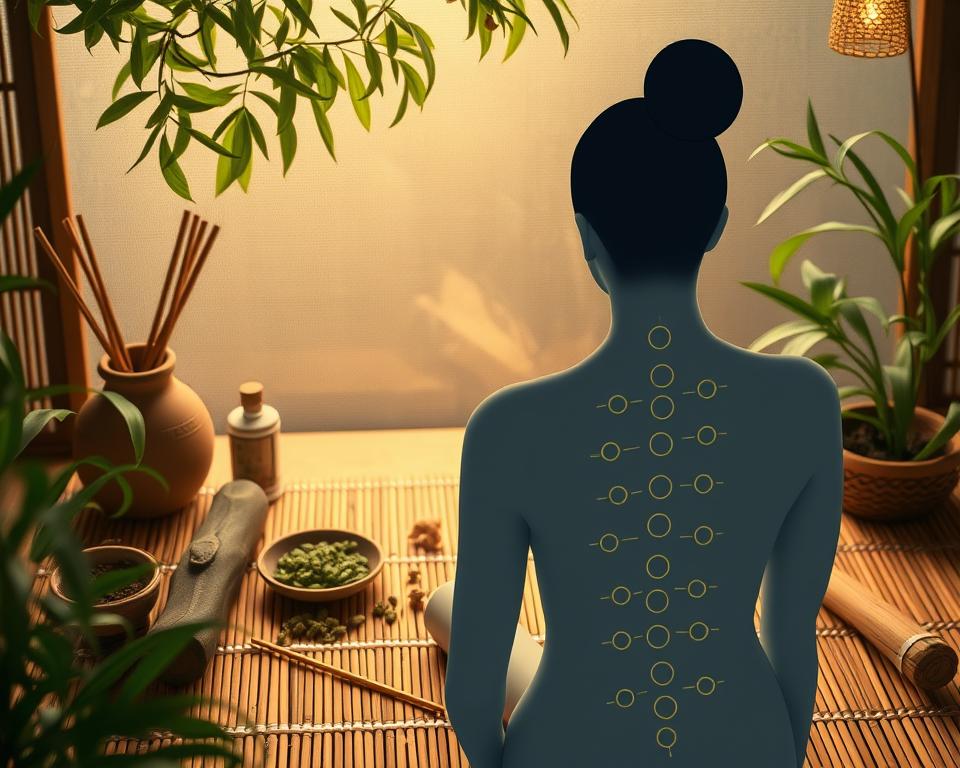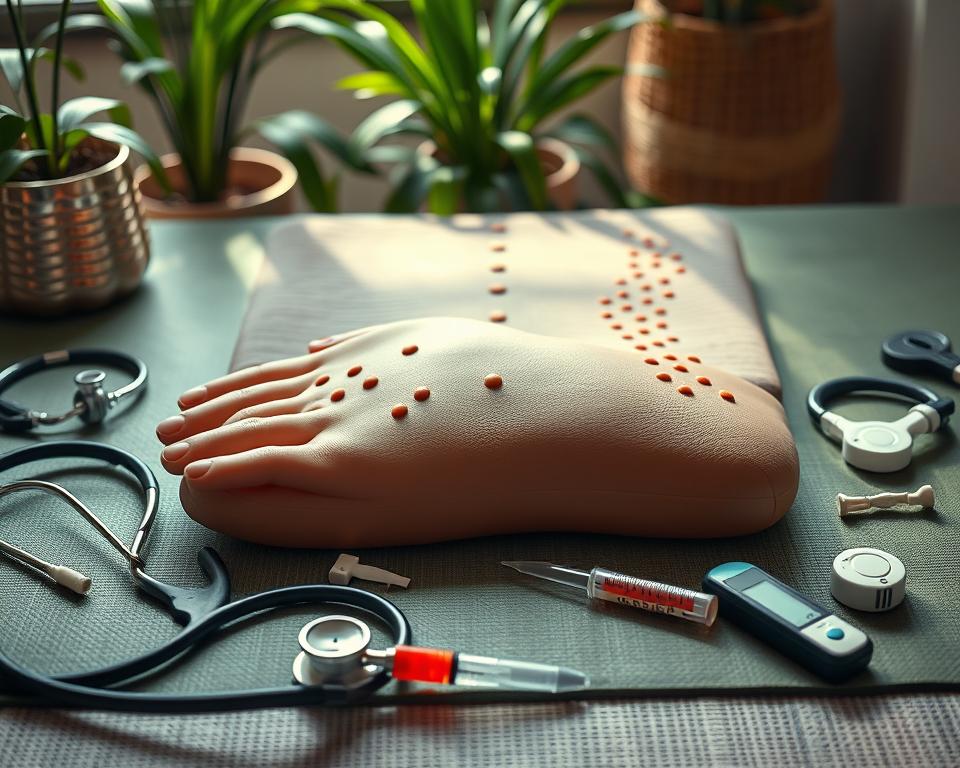Living with diabetes can be tough every day. But, acupressure offers a natural way to handle it. It’s a form of alternative diabetes therapy that uses gentle pressure on the body. This helps in healing and finding natural diabetes remedies.
In this article, we’ll look at how acupressure for diabetes can help. We’ll also give you tips to start using it for holistic diabetes management.
Read more interesting information at ::bizseeds
What is Acupressure?
Acupressure is an ancient Chinese healing practice. It has been used for centuries to promote overall well-being. It involves applying gentle pressure to specific points on the body, known as acupressure points or pressure points. This helps stimulate the body’s natural healing abilities and alleviate various health concerns, including diabetes.
Ancient Chinese Healing Technique
Acupressure is rooted in the principles of traditional Eastern medicine. It is believed that the body’s energy, or chi, flows through channels called meridians. When this energy flow is disrupted, it can lead to physical, emotional, and mental imbalances. Acupressure aims to restore the harmonious flow of chi by applying pressure to the appropriate acupressure points along these meridians.
Pressure Point Therapy
- Acupressure is a form of pressure point therapy that targets specific areas on the body to alleviate various health issues.
- By applying gentle, yet firm, pressure to these points, acupressure practitioners can help to:
- Improve blood circulation
- Reduce inflammation
- Relieve pain and discomfort
- Promote the release of endorphins, the body’s natural pain-relieving chemicals
- Acupressure is often used as a complementary therapy to traditional Eastern medicine and can be a valuable addition to the management of diabetes.
“Acupressure is a gentle yet powerful technique that has been used for centuries to restore balance and promote healing within the body.”
Understanding Diabetes
Diabetes is a complex health condition that affects how the body controls blood sugar levels. There are several types of diabetes, each with its own symptoms and characteristics. Knowing about these types is key to managing and preventing complications.
Types of Diabetes
The main types of diabetes are type 1, type 2, and gestational diabetes. Type 1 diabetes is when the body attacks and destroys insulin-producing cells. Type 2 diabetes is when the body can’t use insulin well. Gestational diabetes happens during pregnancy and usually goes away after giving birth, but it can raise the risk of type 2 diabetes later.
Symptoms and Complications
The symptoms of diabetes vary by type and severity. Common signs include feeling very thirsty and urinating a lot, feeling tired, blurred vision, and losing weight without trying. If diabetes is not treated or managed well, it can cause serious problems like nerve damage, kidney disease, heart issues, and even amputation. It’s important to recognize the early signs and get medical help quickly to avoid long-term health issues.
| Diabetes Type | Symptoms | Complications |
|---|---|---|
| Type 1 |
|
|
| Type 2 |
|
|
| Gestational |
|
|
Understanding the types of diabetes, their symptoms, and potential complications is crucial for effective management and prevention of this chronic condition.
Benefits of Acupressure for Diabetes
Acupressure, an ancient Chinese healing method, is gaining attention for managing diabetes. It targets specific body points to offer benefits that can greatly improve life for those with diabetes.
Improved Blood Sugar Control
Acupressure helps regulate blood sugar levels. It stimulates the body’s natural insulin production and glucose metabolism. This leads to better blood sugar control, especially for those with type 2 diabetes.
Reduced Stress and Anxiety
Diabetes often brings high stress and anxiety levels. Acupressure is a proven stress-reliever. It targets points that promote relaxation, helping manage diabetes-related emotional burdens.
Adding acupressure to a diabetes management plan offers a natural complement to medical treatments. It can lead to better blood sugar control, less stress, and a better quality of life for those with diabetes.
Acupressure Points for Diabetes
Acupressure is a natural way to manage diabetes. It uses gentle pressure on specific points to help the body heal. Knowing the best acupressure points for diabetes is key for self-care.
The Spleen 6 (SP6) point is on the inner leg, near the ankle. Pressing this spot helps control blood sugar and improve insulin use.
- The Large Intestine 4 (LI4) point is on the hand, between the thumb and index finger. It helps reduce stress and anxiety linked to diabetes.
- The Stomach 36 (ST36) point is on the outer leg, below the knee. It boosts glucose metabolism and insulin production.
| Acupressure Point | Location | Benefits for Diabetes |
|---|---|---|
| Spleen 6 (SP6) | Inner aspect of the leg, 4 finger-widths above the ankle | Regulates blood sugar levels, improves insulin sensitivity |
| Large Intestine 4 (LI4) | Hand, between thumb and index finger | Reduces stress and anxiety |
| Stomach 36 (ST36) | Outer aspect of the leg, 4 finger-widths below the knee | Enhances glucose metabolism, regulates insulin production |
Using these acupressure points in your self-care can help manage diabetes. It supports your body’s natural healing abilities.
Acupressure Techniques for Diabetes
Acupressure can help people with diabetes manage their condition. It’s an ancient Chinese healing art with two main ways: self-massage and professional sessions. You can choose what works best for you to feel better and live healthier.
Self-Massage Techniques
You can do acupressure at home with self-massage. Use your fingers to press on certain body points. This helps move energy and heals. It’s easy to add to your daily routine to help manage diabetes.
- Find the acupressure points linked to diabetes, like the “Three Mile Point” on your lower leg.
- Press these points firmly and in circles for 1-2 minutes, do it several times a day.
- Try different pressures to see what feels best and works for you.
Professional Acupressure Sessions
Seeing a trained practitioner for acupressure can be very helpful. They can give you a treatment plan made just for you. They know which points to focus on for diabetes. Regular visits can lead to better diabetes management.
| Benefits of Professional Acupressure Sessions | Benefits of Acupressure Self-Massage |
|---|---|
| Customized treatment plan | Convenience and flexibility |
| Deeper understanding of acupressure principles | Cost-effectiveness |
| Improved overall management of diabetes | Active involvement in your own care |
Try both acupressure self-massage and acupressure sessions to manage diabetes. Find what works best for you. This way, you can use acupressure to improve your health.
acupressure diabetes
Acupressure is a promising therapy for people with diabetes. It targets specific points on the body to manage blood sugar and improve health. Let’s explore how acupressure helps with diabetes.
Acupressure applies gentle pressure to acupoints on the body. These points are linked to energy channels. Stimulating them can balance the body and aid healing. For those with diabetes, acupressure offers several benefits.
- Improved Blood Sugar Control: It can regulate insulin and improve insulin sensitivity. This leads to better blood sugar management.
- Reduced Stress and Anxiety: Diabetes can be stressful. Acupressure reduces stress and anxiety, improving overall health.
- Alleviation of Complications: It may ease diabetes-related issues like neuropathy and wound healing problems.
Adding acupressure to diabetes care can be a natural and holistic approach. It can be done through self-massage or professional sessions. This ancient practice is a valuable part of a comprehensive care plan.
“Acupressure has been a game-changer for me in managing my diabetes. It’s helped me control my blood sugar levels, reduce stress, and feel more in tune with my body.”
– Sarah, a diabetes patient who has been practicing acupressure for over a year.
| Benefit | Description |
|---|---|
| Improved Blood Sugar Control | Acupressure can help regulate insulin production and improve the body’s sensitivity to insulin, leading to better management of blood sugar levels. |
| Reduced Stress and Anxiety | Acupressure has been shown to reduce stress and anxiety, which can have a positive impact on overall health and well-being for individuals with diabetes. |
| Alleviation of Complications | Acupressure may help alleviate some of the common complications associated with diabetes, such as neuropathy, circulatory issues, and wound healing problems. |
Incorporating Acupressure into Your Routine
Adding acupressure to your daily routine can help manage diabetes better. It’s good to know when and how to use it with other treatments. This way, you can manage your diabetes in a holistic way.
When to Practice Acupressure
Acupressure is useful at different times. Try it before meals to control blood sugar or when stressed to relax. Making it a regular part of your acupressure diabetes routine boosts your health.
Combining with Other Therapies
Acupressure works well with your current diabetes plan. When combining acupressure with western medicine, you get better health benefits. Pair it with diet, exercise, or other therapies like mindfulness or herbs for a acupressure with other therapies approach.
| Acupressure Technique | Optimal Timing | Complementary Therapy |
|---|---|---|
| Spleen Point | Before Meals | Medication |
| Liver Point | During Stress | Mindfulness |
| Kidney Point | Before Bed | Herbal Supplements |
By adding acupressure to your daily life and combining acupressure with western medicine, you manage diabetes more effectively. This leads to better health outcomes.
Precautions and Safety Considerations
Acupressure is usually safe and doesn’t hurt. But, people with diabetes need to be careful. It’s important to practice acupressure safely to get the best results.
People with diabetes should watch their blood sugar closely. Acupressure can change hormone and energy levels. This might affect blood sugar. Always check blood sugar before and after acupressure and talk to a doctor.
There’s also a risk of infection. Acupressure involves pressing on the body. People with diabetes might get infections more easily. Make sure to clean the skin well and use clean tools.
Some acupressure points might not be safe for everyone. It’s key to find a trained acupressure practitioner. They can make sure the therapy is right for you.
To safely use acupressure for diabetes, remember these tips:
- Check blood sugar before and after acupressure
- Keep everything clean during acupressure
- Talk to a doctor or acupressure expert about safety
- Start with gentle acupressure and slowly increase
- Stop if you feel any pain or discomfort
By taking these steps, you can use acupressure safely for diabetes. You might find it helps a lot.
Traditional Eastern Medicine and Diabetes
Traditional Eastern medicine offers a unique way to manage diabetes. It views the body, mind, and spirit as connected. This approach is refreshing for managing chronic diseases.
Holistic Approach to Diabetes Management
At the core of traditional Eastern medicine is the idea of balance. It focuses on the body’s natural energies, called chi or qi. For diabetes, it looks at physical, emotional, and spiritual aspects.
Acupressure is a key part of this philosophy. It involves applying gentle pressure to certain body points. Practitioners believe it can balance energy, control blood sugar, and improve well-being.

The ancient Chinese medicine for diabetes also includes diet, herbs, and mind-body practices. These help manage the condition from all angles. It encourages people with diabetes to understand their health deeply and tailor care to their needs.
Using traditional Eastern medicine for diabetes can lead to better blood sugar control. It also reduces stress and improves life quality.
Success Stories and Testimonials
Managing diabetes is a big challenge, but many have found relief with acupressure. These acupressure diabetes success stories and acupressure diabetes testimonials show how it can change lives. They remind us of the power of this ancient Chinese healing method.
Sarah, a 42-year-old with type 2 diabetes, was skeptical at first. But after trying acupressure, she saw big improvements in her blood sugar levels. She also felt less stressed, which helped her control her diabetes better.
“Acupressure has been a game-changer for me. I no longer rely solely on medication, and my overall quality of life has drastically improved.” – Emily, 58, living with type 1 diabetes
For many, acupressure does more than just help with blood sugar. Michael, a 55-year-old with diabetic neuropathy, found relief from numbness and tingling in his feet. This allowed him to stay active and enjoy life more.
| Name | Diabetes Type | Acupressure Benefits |
|---|---|---|
| Sarah | Type 2 | Improved blood sugar control, reduced stress |
| Emily | Type 1 | Reduced reliance on medication, improved quality of life |
| Michael | Type 2 (with neuropathy) | Alleviated numbness and tingling, improved mobility |
These stories show the big impact acupressure can have on diabetes patients. As more people try it, the acupressure diabetes success stories and acupressure diabetes testimonials keep inspiring others. They encourage people to explore this natural way to better health and well-being.
Resources for Learning Acupressure
If you’re interested in learning more about acupressure, there are many resources available. You can find books, guides, online courses, and educational videos. These tools can help you understand and master acupressure techniques.
Books and Guides
For those who like a hands-on approach, there are many acupressure books and guides. They offer step-by-step instructions and illustrations. Some top picks include:
- Acupressure for Diabetes: Natural Remedies to Balance Blood Sugar by Michael Reed Gach
- The Acupressure Atlas by Bernard C. Kolster and Astrid Waskowiak
- Acupressure: The Complete Guide to Acupressure Points and Self-Massage by Ashley Mancini
Online Courses and Videos
There are also online platforms with acupressure online courses and acupressure learning resources. These formats let you learn at your own pace. They show how acupressure can help manage diabetes. Some popular choices are:
- Acupressure for Diabetes on Udemy
- Acupressure.com Online Courses
- Acupressure for Diabetes YouTube Tutorial
By checking out these acupressure books, guides, courses, and videos, you can learn a lot. You’ll see how acupressure can be a key part of managing diabetes.
Integrating Acupressure with Western Medicine
Acupressure, an ancient Chinese healing technique, can be a valuable complement to conventional Western medical treatments for diabetes. It can be added to a comprehensive diabetes management plan. This way, individuals can benefit from a more holistic approach to their care.
By combining acupressure with western medicine, diabetes management becomes more effective. Acupressure helps regulate blood sugar levels and reduces stress and anxiety. At the same time, conventional therapies provide a structured medical framework.
The integration of acupressure and conventional diabetes treatment is especially beneficial. It helps individuals better manage their condition and improve their overall well-being. By incorporating acupressure into their routine, patients can experience a more personalized and holistic approach to their care.
| Benefit | Acupressure | Conventional Diabetes Treatment |
|---|---|---|
| Blood Sugar Control | Helps regulate blood sugar levels | Medications, insulin therapy, dietary management |
| Stress Reduction | Lowers stress and anxiety levels | Counseling, relaxation techniques |
| Symptom Management | Addresses various diabetes-related symptoms | Medications, lifestyle modifications |
By integrating acupressure with western medicine, individuals with diabetes can experience a more comprehensive and personalized approach to their care. This helps them better manage their condition and improve their overall quality of life.

“Acupressure has been a game-changer for me in managing my diabetes. By combining it with my conventional treatment, I’ve been able to better control my blood sugar levels and reduce the stress that comes with this condition.”
Conclusion
Acupressure is a natural way to manage diabetes and its symptoms. It targets specific points on the body. This ancient Chinese method can help control blood sugar, reduce stress, and improve overall health.
It can be done by self-massage or with a professional’s help. Acupressure is a valuable part of a diabetes management plan. It can help improve blood sugar control and reduce stress and anxiety.
Using acupressure for diabetes, natural diabetes remedies, and a holistic diabetes management approach helps individuals take charge of their health. Acupressure can help manage symptoms better, improve life quality, and reduce the need for traditional treatments.
As people look for alternative therapies, acupressure for diabetes becomes more popular. It leads to a more personalized healthcare approach. By using acupressure, those with diabetes can feel more in control and on the path to better health.
